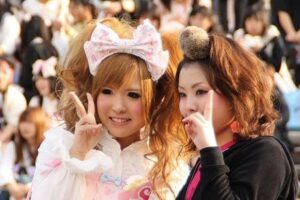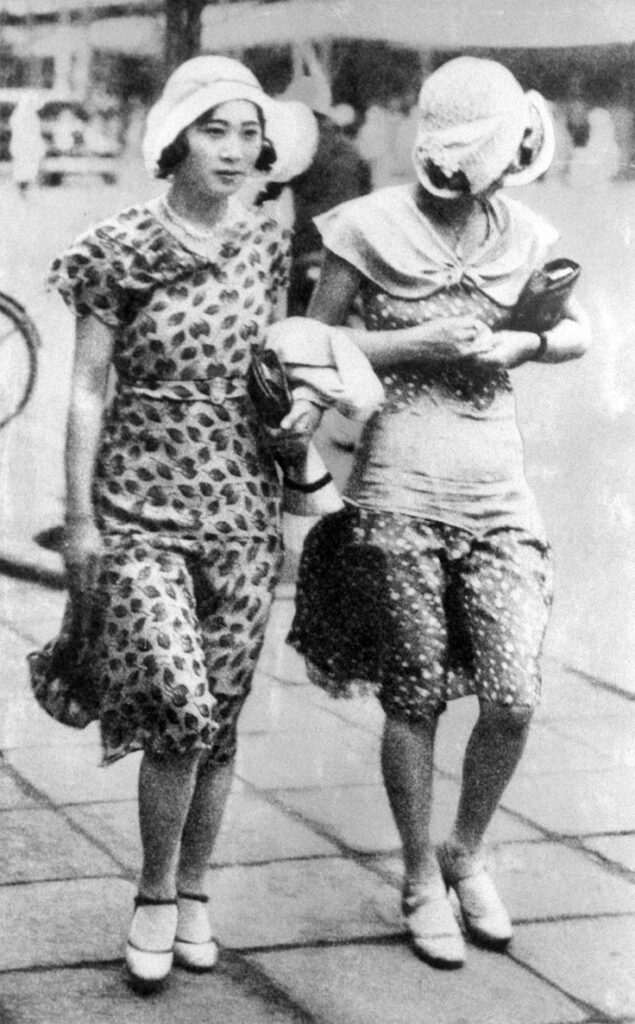Japan in the 1920s and 1930s was a time of rapid social and cultural change, as the country embraced Western influences and modernized its economy, politics, and lifestyle. One of the most visible and influential manifestations of this change was the emergence of the modern girls, or moga, who were young women who adopted Western fashion, behaviour, and values. They challenged the traditional norms of femininity, sexuality, and family, and sought greater personal freedom and independence. They also influenced Western culture in various ways, such as popularizing new forms of communication, entertainment, and consumerism.

Communication: Texting and Emojis
One of the ways that moga influenced Western culture was by pioneering new forms of communication, such as texting and emojis. Moga were avid users of telephones, which were becoming more accessible and affordable in Japan at the time. They used telephones to chat with their friends, arrange dates, and express their emotions. They also developed a shorthand language of abbreviations, symbols, and slang, which they used to write messages on postcards, letters, and diaries. This language was similar to the modern texting language that emerged in the West in the late 20th century, with the advent of mobile phones and the internet.
Moga also used pictorial symbols to convey their feelings and moods, such as hearts, stars, flowers, and animals. These symbols were the precursors of the emojis, or emoticons, that are widely used in digital communication today. Emojis originated in Japan in the 1990s, when a software engineer named Shigetaka Kurita created a set of 176 icons for a mobile internet platform. He was inspired by the weather symbols, manga comics, and kanji characters that he saw in everyday life. Emojis soon became popular among Japanese mobile users, and later spread to the rest of the world, as they were adopted by various platforms and applications.
Entertainment: Selfies and Karaoke
Another way that moga influenced Western culture was by popularizing new forms of entertainment, such as selfies and karaoke. Moga were fascinated by photography, which was becoming more accessible and affordable in Japan at the time. They used cameras to take pictures of themselves, their friends, and their surroundings, and to document their lives and experiences. They also posed for professional photographers, who captured their fashionable outfits, hairstyles, and expressions. These photographs were the predecessors of the selfies, or self-portraits, that are widely taken and shared in social media today. Selfies originated in Japan in the early 2000s, when camera phones were introduced and became popular among young people. They were initially called purikura, or print club, which referred to the photo booths that allowed users to take and print stickers of their pictures.
Moga also enjoyed singing, dancing, and listening to music, which were becoming more accessible and affordable in Japan at the time. They frequented cafes, bars, and clubs, where they listened to jazz, blues, and pop music from the West, and sang along with their favourite songs. They also performed in amateur contests, where they showcased their talents and competed for prizes. These activities were the predecessors of the karaoke, or sing-along, that are widely enjoyed in social settings today. Karaoke originated in Japan in the 1970s, when a musician named Daisuke Inoue invented a machine that played recorded music and displayed the lyrics on a screen. He was inspired by the requests of his customers, who wanted to sing along with his music. Karaoke soon became popular among Japanese people, and later spread to the rest of the world, as they were adopted by various venues and devices.
Consumerism: Hello Kitty and Kawaii
A third way that moga influenced Western culture was by promoting new forms of consumerism, such as Hello Kitty and kawaii. Moga were avid consumers, who spent their money on fashionable clothes, accessories, cosmetics, and gadgets. They also collected and exchanged various items, such as dolls, toys, stickers, and stationery, that featured cute and colourful designs. These items were the predecessors of the Hello Kitty, or Kitty-chan, that are widely loved and consumed in the world today. Hello Kitty originated in Japan in the 1970s, when a designer named Yuko Shimizu created a character of a white cat with a red bow for a company called Sanrio. She was inspired by the British culture, which she admired and studied. Hello Kitty soon became popular among Japanese girls, and later spread to the rest of the world, as they were licensed by various products and media.
Moga also created and embraced a culture of cuteness, or kawaii, that pervaded their lives and expressions. They used kawaii to describe themselves, their friends, their items, and their experiences, and to communicate their emotions and moods. They also adopted kawaii as a style, a attitude, and a philosophy, that reflected their innocence, playfulness, and individuality. Kawaii was the predecessor of the global phenomenon of cute culture, that is widely seen and practiced in the world today. Kawaii originated in Japan in the 1970s, when a subculture of young people started to write and draw in a childish and whimsical manner, using pastel colors, round shapes, and exaggerated features. They were inspired by the manga comics, anime cartoons, and video games that they grew up with. Kawaii soon became popular among Japanese people, and later spread to the rest of the world, as they were influenced by various celebrities and trends.

Japan’s modern girls, or moga, were not only the pioneers of Japanese modernism, but also the catalysts of Western culture. They influenced the West in various ways, such as popularizing new forms of communication, entertainment, and consumerism, that are still widely used and enjoyed today. They also challenged the traditional norms of femininity, sexuality, and family, and sought greater personal freedom and independence, that are still relevant and inspiring today. They were the audacious and influential women, who shaped the history and culture of Japan and the world.